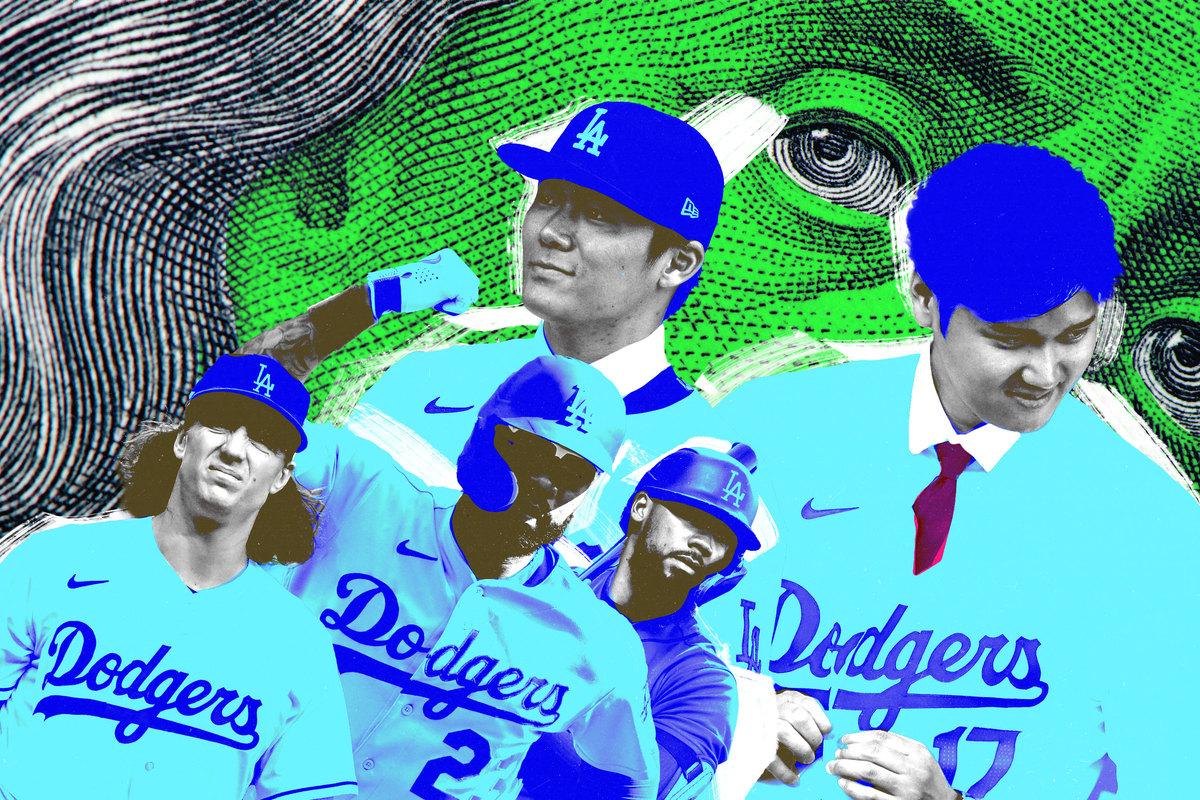
First came “$10,000 Kelly” and the “$11,000 beauty.” Then there was the “$100,000 infield” and the “million-dollar outfield.” Now, after a century or so of inflation, labor action, and revenue growth, there’s a new entry in the annals of milestone spending in baseball: the “billion-dollar offseason.”
The Los Angeles Dodgers have committed more than $1 billion in future payments this winter, and they might not be done adding players and payroll. As is always the case when a big-market team flexes financial might, the splurge has sparked complaints and debates about competitive balance, salary scales and caps, and California tax code. (OK, California tax code is kind of a new one.) But the Dodgers’ gotta-sign-’em-all spree differs somewhat from past splashes. Although their money made this accumulation of star power possible, their capacity to outspend other suitors isn’t their only edge. Their dollars are made even more daunting by the twin trump cards they hold: their competitive track record, and their player-development prowess. In any given negotiation, other teams can match them in hard cash, but it’s tough to top them in soft factors.
That the Dodgers’ advantage goes deeper than their pockets makes them formidable—maybe even unbeatable—in a bidding war (if not in October). In addition to re-signing reliever Joe Kelly and platoon outfielder Jason Heyward, the Dodgers have inked the sport’s top two free agents (Shohei Ohtani and Yoshinobu Yamamoto) to record contracts, acquired and extended perhaps the best starting pitcher available via trade (Tyler Glasnow), and signed one of the biggest bats on the thin free-agent market for position players (Teoscar Hernández). And although the team could almost certainly waltz into October with its current talent, Andrew Friedman’s front office may still shore up the roster’s relative weak points by, say, swapping depth pieces for another shortstop or starter, or bringing back free agent (and franchise icon) Clayton Kershaw, who’s recovering from shoulder surgery.
Although few clubs could or would spend this much money in total, plenty of teams could have managed to match the Dodgers’ offers in any individual deal—and, in fact, a few did. Per ESPN’s Jeff Passan, the Giants and Blue Jays joined the Dodgers in meeting Ohtani’s asking price, and The Athletic’s Ken Rosenthal reported that the Yankees and Mets made competitive proposals to Yamamoto. (The Giants and Red Sox were also said to be strongly in the Yamamoto mix.) Passan also reported that Hernández “opted for a big one-year deal with the best team over other multiyear offers.” It’s increasingly clear that contracts being equal—or remotely close—everyone wants to be a Dodger. “Like Shohei Ohtani … Yamamoto appeared to have a specific team he wanted to join,” Rosenthal wrote. “And that team was the Dodgers.”
In some of these cases, the Dodgers’ differentiators were partly player-specific. Glasnow grew up close to Los Angeles, rooting for the team. Ohtani was already living and playing in Southern California, where his longtime interpreter, Ippei Mizuhara, was raised. For Ohtani and Yamamoto, the West Coast is closer to family in Japan, and both had deep-seated affinities for the franchise due to the Dodgers’ past employment of prominent Japanese pitchers. But all three players also appeared to consider tough-to-counter tiebreakers that would aid L.A. in almost any courtship: championship probability and player improvement.
Glasnow said, “The goal is obviously to win a World Series,” which the Dodgers prevented him from doing with the Rays in 2020. Through Mizuhara, Ohtani explained, “I want to win championships” and “They were all about winning, and that’s exactly how I feel.” And Yamamoto stated, “Winning now and winning into the future was probably the most important thing in making this decision.” Most free agents pay lip service to winning wherever they sign, and it’s easy to say winning is paramount when the pay is great too. But the sentiment rings true in this instance, considering the Dodgers are one of the most dominant regular-season teams of all time.
Although they’ve often flamed out in the playoffs, the Dodgers have made it to the tournament 11 years in a row (the third-longest streak ever), 10 times via division titles. There’s no such thing as a perpetual motion machine or a perpetual playoff team, but the Dodgers are doing a passable impression of the latter. And given the inherent randomness of October baseball, qualifying for the postseason as many times as possible is the surest way to up the odds of a ring.
And then there’s the idea that the Dodgers optimize players. Glasnow said, “It’s a really good place for me to get better as a pitcher.” According to Sports Illustrated’s Tom Verducci, Ohtani “made a point of asking the club about its player development philosophy and the state of its minor league system.” He may have made a point of asking every team he talked to about those things, but the Dodgers probably had the most impressive response: Their knack for improving players is well established, and their farm system ranks sixth (at FanGraphs) despite the fact that they haven’t picked higher than 20th in the amateur draft since 2013. The Dodgers also hired the movement guru who helped the meticulous Yamamoto overhaul his delivery entering 2023.
In the past, the Dodgers have drawn on their reputation for unlocking latent talent—dating back to the likes of Justin Turner and Max Muncy—to secure signings and discounts. Reliever Yency Almonte followed the advice of former teammate Jake McGee, who’d had a bounceback in L.A., and signed a minor league deal with the Dodgers in hopes of having his own resurgence. (In year one, it went well: His ERA fell from 7.55 to 1.02.) Tyler Anderson turned down opportunities to start elsewhere in favor of a long-relief role with the Dodgers, driven by both his desire to win and his interest in their developmental acumen. Andrew Heaney joined the team after buying into Friedman’s talk of “levers that we feel we can potentially pull with him … to really tap into something,” which Heaney referred to as “tweaks that had never really crossed my mind or never been brought to my attention.” And Noah Syndergaard tried to follow in their footsteps, citing the Anderson/Heaney improvement precedent as his reason for passing up longer and larger offers in favor of a one-year, $13 million deal with the Dodgers. (“I feel like everything that they touch turns to gold,” Syndergaard said, though the Rumpelstiltskin act didn’t work with him.)
Elite talents like Ohtani, Yamamoto, and Glasnow may not be in need of immediate Dodgers makeovers, but even great players sometimes tinker on the margins—and during long-term deals, even unicorns decline. Even if these stars are satisfied with their own performance, they’re probably pleased that the Dodgers are solid candidates to keep making the mere mortals around them better—and to keep persuading other players to sign. In essence, we’re seeing a snowball effect: Each “How did they do that?” success story and each Infinity Free Agent they collect helps convince the next star to assimilate into the Dodgers collective, as evidenced by Freddie Freeman and Mookie Betts rolling out the red carpet for Ohtani, and Ohtani doing the same for Yamamoto and Glasnow. It doesn’t hurt that Ohtani and Hernández, like Betts and Freeman before them, deferred millions—or, in Ohtani’s case, hundreds of millions—to make it more feasible for the Dodgers to keep strengthening their roster right now.
It’s impossible to separate the Dodgers’ resources—bolstered by a lucrative long-term broadcast deal that shields them from much of the uncertainty surrounding the dissolution of the cable bubble—from either their winning or their development program. But although they have been baseball’s biggest spenders over the past decade, they’ve rarely held large leads in single-season payroll. Even now, they’re second in projected payroll for 2024, behind the Mets—a team that’s tried to model itself after the Dodgers, thus far with spotty results. Underpaid prospects and reclamation projects have helped the Dodgers keep their spending within sight of some other aggressive organizations, even when they break the bank on big names.
Although the Dodgers’ present spending doesn’t come close to lapping the league’s like the “Evil Empire”–era Yankees’ used to, their list of additions does smack of The Onion’s famous story about the Yankees locking up a pennant by signing every player in baseball. The Dodgers haven’t always been the heels who cornered the market like this: Prior to the Ohtani, Yamamoto, and Glasnow signings, they had only four players under contract for 2025, and two for 2026. Last winter, they let a lot of productive players leave, perhaps partly in a fruitless attempt to dip below the competitive-balance tax threshold in preparation for this winter’s baseball bacchanal. In recent years, they’ve not only seen their own premium players (such as Corey Seager, Max Scherzer, and Trea Turner) walk away as free agents, but they’ve also come up up short in their pursuits of outside superstars (such as Bryce Harper, Gerrit Cole, and Justin Verlander).
What we’ve seen this winter, then, represents something of a new phase in the Dodgers’ assault on the standings—and in their transition to baseball bullies, from their opponents’ standpoint. And that’s a scary prospect, considering how hard it’s been for the better part of a decade to envision the Dodgers ever being bad.
So what do you do if you have to go toe-to-toe with this team, as the Padres tried to? Where should a division rival like the Giants turn after Ohtani spurned them, and Yamamoto, via agent Joel Wolfe, unintentionally twisted the knife with the cruelest of backhanded compliments? (“If the Dodgers had not been pursuing him, there was a good chance San Francisco could have been his destination.”) How can you beat them if everyone wants to join them?
You have to hope that their hit rate with their priority targets will regress to the mean, or that their roster will be so stacked that they’ll stop bogarting baseball’s best free agents. You can cross your fingers that their stars will get old, that they won’t be available for big games—see the state of L.A.’s rotation in last year’s NL Division Series—or that their ownership will decide it doesn’t want to keep paying payroll penalties. And although Glasnow recently described the Dodgers as a “super duper team,” they aren’t that much better than the rest of baseball’s best teams. (In fact, FanGraphs’ projections still put them a tad behind the Braves.)
You can appeal to prospective players’ egos, offering them the chance to be the face of a franchise rather than one of many luminaries in the Dodgers’ constellation of stars. You can, perhaps, dangle greater guarantees of playing time on teams with less depth. You can try to beat the Dodgers at their own recruiting game: For instance, according to Jon Heyman, at least one team was willing to “more than double the guarantee” Shota Imanaga got from Chicago, but “he wanted to be a Cub.” (Then again, the Dodgers weren’t reported to be players in the Imanaga sweepstakes.) Or you can do more than merely match a Dodgers package: You can try to top it. The Dodgers have been outbid before, but no one, it seems, has blown the team’s offers away this winter.
Maybe you dream of a day when Friedman or owner Mark Walter leaves—an eventuality Ohtani hedged against—and the Dodgers become complacent. Despite being a playoff fixture in every season since the 18-year-old Ohtani’s NPB debut, the Dodgers have gone all the way only once, in a pandemic-shortened season. They still have something to prove, and they operate with the urgency of a team on the upswing, not a storied, 140-year-old franchise that the oddsmakers consider a perennial favorite. For all of their excellence, the Dodgers still bemoan their failures, both publicly and to Ohtani. Failure can be the best motivator, so as clutching-at-straws as it sounds to suggest that the secret to dismantling the Dodgers is first to be beaten by them, maybe more winning will blunt their edge.
And if all of that fails? Well, you can count on the same built-in guardrail that typically prevents baseball teams from purchasing championships, and that’s prevented a postseason Dodgers dynasty thus far. No matter how compelling your presentation to superstars, no matter how star-studded your rotation and lineup, and no matter how much you shift the odds in your favor, one painful or—depending on your perspective—merciful fact remains: There’s no certain defense against failure in a five- or seven-game series.

